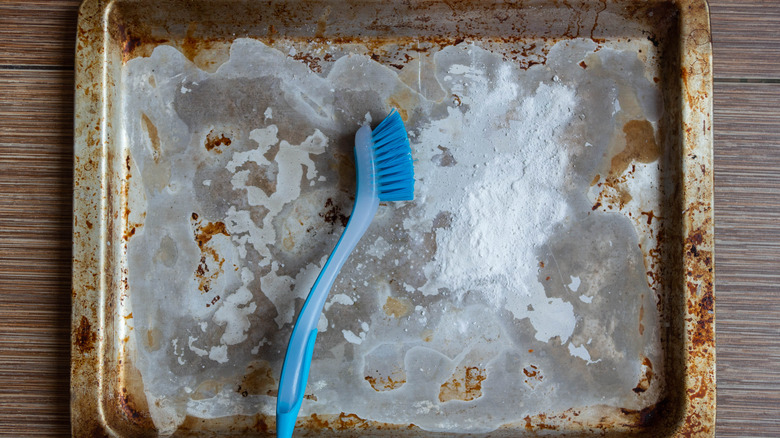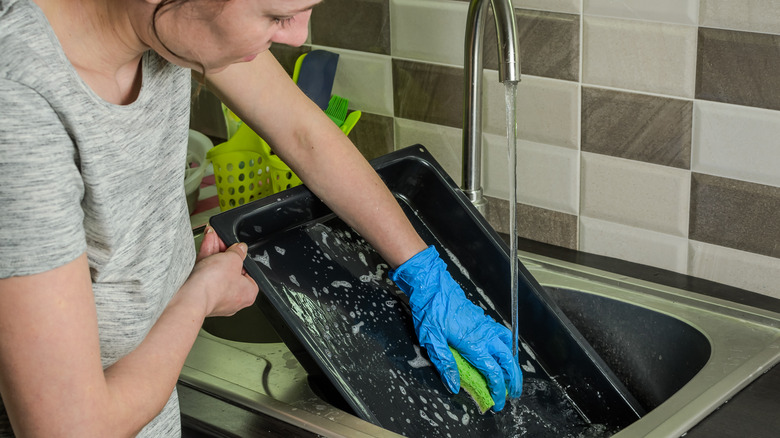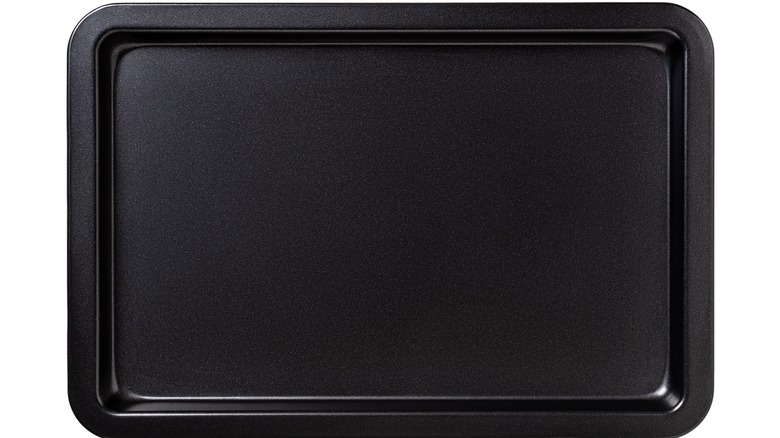How To Clean Your Dingy Baking Sheets So They Look Like New Again
Baking sheets are somewhat of a point of contention in my house. You see, I have nice, big, pristine aluminum baking pans, and if you don't know how to clean cookie sheets correctly, you don't get to use my precious cookware. Because I'm so fond of my shiny, immaculate set, I tend to hide the clean sheet pans from my housemates, forcing them to use old, gross backup sets that have been around forever.
Some may think this is rude, but I know they won't take good care of a good set. I solely use them with silicone mats and avoid acidic foods that could stain them. Beyond that, I clean them right away to ensure they stay in good shape. Maybe I'm a little extreme, but I love how fresh and new they look, even after years of use! If you're like me and take pride in your immaculate baking sheets, it's vital to know the right way to clean certain materials to remove residue, stains, and burns, leaving them as beautiful as the day you bought them.
What you use to clean your baking sheets depends on the material. However, this task can typically be accomplished with everyday household items like vinegar, baking soda, and hydrogen peroxide. From there, it's up to you and your elbow grease — and some carefully applied techniques — to get them sparkling clean.
How to clean aluminum and aluminized steel baking sheets
Many bakers swear by aluminum baking sheets because of their ability to conduct heat evenly. However, this material can react with acidic substances, creating a metallic taste and leaving unsightly stains. To clean aluminum baking sheets, sprinkle a layer of baking soda over it, then follow it up with a layer of salt. Put white vinegar in a spray bottle, then spritz a layer of the liquid over your pan. From here, you can either start scrubbing with a sponge or, to make your work a little easier, soak the pan in hot water for 30 to 60 minutes first. After you've worked off stains and caked-on food, wash the pan with regular soap and water.
Aluminized steel is essentially steel that's coated in an aluminum alloy. These pans are strong, durable, and can vary in appearance from standard gray to pretty gold finishes. To clean these pans, sprinkle a layer of baking soda onto your sheet, then pour on a generous amount of hydrogen peroxide. If needed, add more baking soda until it resembles a paste. The key is to allow the mixture to work its magic, so you have to be patient. Let the pan sit for two or three hours, then wipe it away with a cloth. You can use a coarse sponge to scrub at stubborn spots if needed, but wash it with soap and water before using it again.
How to clean nonstick baking sheets
In theory, nonstick baking pans are supposed to be spared from stains, burns, and caked-on food. However, if you use any oil on nonstick pans, there's a chance a sticky brown residue will develop over time. Since you can't scrub these pans too hard without risking damaging the nonstick finish, getting rid of the baked-on goo can be tricky. One safe tactic involves mixing water and baking soda into a paste-like consistency. Cover your cookie sheet in the paste and let it sit for 30 minutes. You can then take a non-abrasive sponge and scrub at the residue.
After you've gotten your pans looking fresh, you can take several easy steps to keep them from getting stained and discolored again. One of the easiest methods is to invest in silicone mats, which protect the surface of your pans without affecting their conduction properties. Depending on what you plan to cook, you can also use parchment paper or aluminum foil as a protective layer for your pans. Parchment paper is nonstick, making it a good option for cookies and other foods that may otherwise get stuck to the pan.


